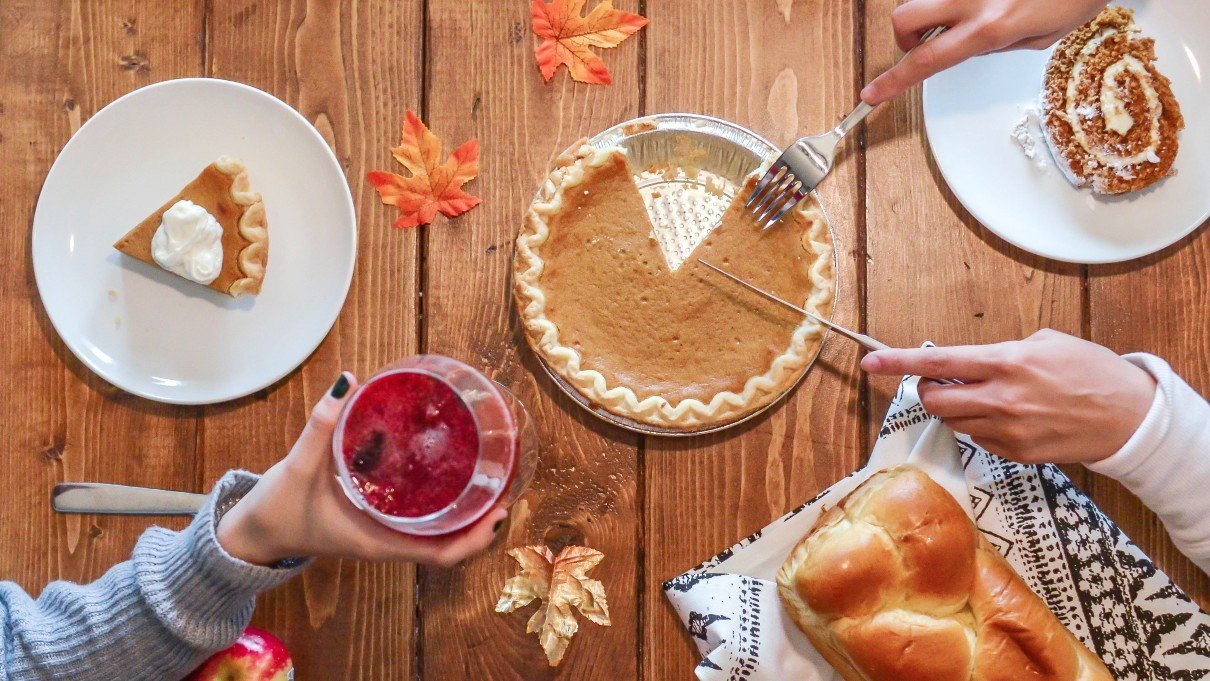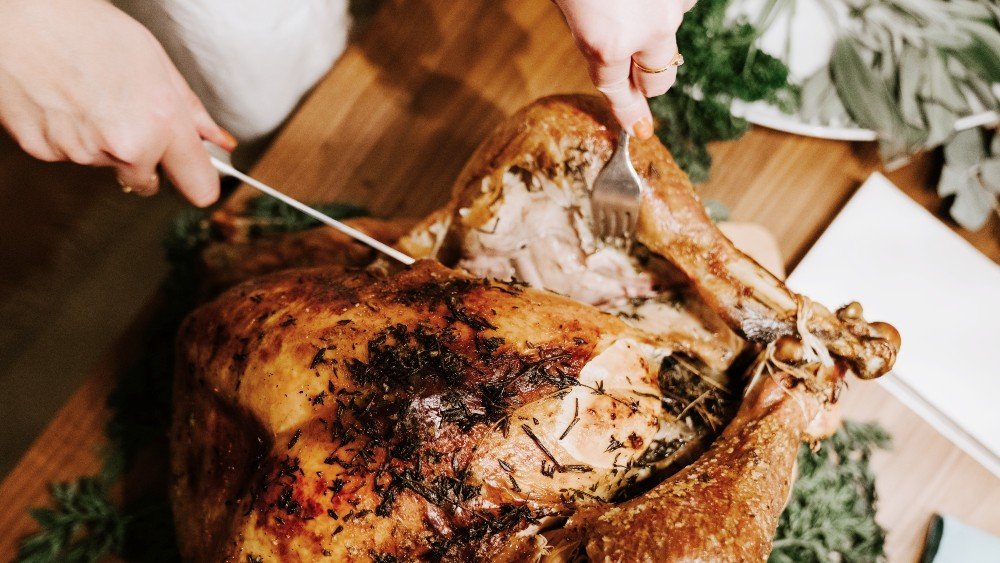How Can We Be More Sustainable on Thanksgiving

In recent years, the controversial history of Thanksgiving has become more well-known.
While many have stopped celebrating or transformed the holiday, over 50 million Americans celebrate each year, with many of them traveling across states to meet with friends and family.
This mass traveling is just one reason why Thanksgiving is bad for the environment. Huge amounts of food waste are sent to landfills after the holiday, with less than 10% of waste composted.
Instead of celebrating food, the holiday wastes even more food than usual, wasting the energy and water used to produce it and filling up landfill sites.
How bad is Thanksgiving for the environment?
The carbon footprint of a typical Thanksgiving meal is primarily influenced by travel, turkey, throwing away leftovers, and where you shop.
Turkey and travel are the biggest carbon dioxide producers for the holiday, with millions of pounds of CO2 produced by turkey alone each year and a further 10.8 billion pounds of CO2 produced by car travel.
Air travel adds on 800 million pounds of CO2 from an estimated 3 million Americans traveling cross-state for the holiday.
Where you live also influences the environmental impact of your Thanksgiving celebrations.
A 16-pound turkey can create up to 34.2 pounds of CO2 according to research by Carnegie Mellon University, based on an example of cooking turkey in an electric oven in Wyoming, which relies on coal to produce 80% of its electricity.
In Maine, using electricity produced primarily by renewable energy to cook a 16-pound turkey creates up to 3 pounds of CO2.
Food waste is the biggest contributor next to travel when it comes to Thanksgiving’s environmental impact.
It’s estimated that only 6.3% of food waste is composted, with the rest sent to landfills where it releases methane and traps nutrients.
Worse, every bit of food wasted also wastes the energy and water that has gone into growing it.
How do Thanksgiving turkeys affect the environment?
According to the Environmental Working Group, one kilogram of turkey produces 10.9 kg of CO2 emissions during its lifecycle. They estimate that 31% of the turkey is discarded, contributing to a great deal of food waste.

The Natural Resources Defense Council estimates that over 200 million pounds of turkey meat are thrown out every Thanksgiving.
All the energy and water used to produce that turkey meat is equivalent to every American household running their faucet for six hours. The wasted turkey meat could fulfill the daily protein intake of over 500 million adults, amounting to 25.6 billion grams of protein.
How to have a sustainable Thanksgiving
Because the majority of Thanksgiving’s carbon dioxide emissions come from travel and turkey, it’s easy to make your Thanksgiving sustainable.
Reducing your holiday carbon footprint can be done by changing just a few traditions and making the most of what you already have.
Here are some travel tips to help reduce your travel emissions. If you’re hosting Thanksgiving dinner, try to encourage your guests to follow these travel tips:
- Take public transport instead of driving yourself
- Carpooling with other friends or relatives
- Travel a few days before Thanksgiving to avoid traffic and leave before Sunday
- Plan Thanksgiving for a different week to reduce travel time
Leftovers and food waste are the biggest problems to face with Thanksgiving dinner, so when you’re hosting dinner make sure to take steps to reduce it.
As a guest, offering to take some leftovers away with you will help as well.
Here are some tips on how to have a sustainable Thanksgiving dinner to reduce food waste:
- Only prepare as much as you know will be eaten
- Buy only what you need and plan for
- Buy local and organic ingredients
- Reduce how much you peel vegetables and use the skins in your recipes
- Ask guests to bring containers to take away leftovers
- Plan creatively to use up all your leftovers
- Freeze leftovers to use another day
- Instead of throwing away burnt food, try reviving your food first
- Compost or bokashi anything you can’t eat
- Eat less meat – buy smaller turkeys or try Tofurkey
- Donate your leftovers locally to food banks or shelters
If you’re not able to compost your food, find out if you have any local composting schemes to send food waste to.
It’s better to hold on to leftovers and eat them later than throwing them out – it means you’re not buying more perishable food that might also be wasted.
Sustainable Thanksgiving recipes
The best sustainable Thanksgiving recipes are those that are made from scratch.
While it’s a lot of work compared to buying pre-produced ingredients, the less prepared your ingredients are the smaller their carbon footprint.
Always check your cupboards and pantry before committing to any recipes – using what you already have cuts down on food waste as well!
If a recipe uses only half of an ingredient, try to find a complementary recipe that will use the rest.
When searching for recipes, use keywords like ‘organic’, ‘vegan’, and ‘sustainable’ to find the most eco-friendly options.
Here are some suggestions for sustainable Thanksgiving recipes:
- The Green Loot’s 40+ vegan Thanksgiving recipes and vegan dessert recipes
- Mother Earth News’ sustainable Thanksgiving meals and recipes – including sustainable turkey options
- GreenChoice’s Thanksgiving food swaps
- Stuffed pumpkin with baked vegetables (less water used for cleaning up!)
- Pumpkin bread from Good Housekeeping
Sustainable Thanksgiving decorations
Thanksgiving is the best holiday for sustainable decorations, as the autumnal aesthetic can be made with completely natural decorations.
Gourds and pumpkins can be used for decorating and food, so if a recipe calls for only the insides of pumpkin use the shell to put in some twigs, leaves, and flowers for a makeshift centerpiece.
Make the most of what you already have where you can – a plain table or ordinary tablecloth can be elevated with creative placements of sticks and flowers. You could even go hunting for pinecones to add to the vibe. Delicately placed leaves on a white tablecloth can give you a minimalistic artsy look to your table.
A bowl or tree of thanks and gratitude can be made on the day as a centerpiece. Take some recycled paper and a few pencils and ask family and guests to write what they’re thankful for. You can tie it to a tree with some string, or just use an ordinary bowl.
Recycled paper can be used for paper garlands, arts and crafts, paper turkeys, and more. You can use leaves to create colorful, autumnal flowers and art too. Make sure to use eco-friendly glue!
